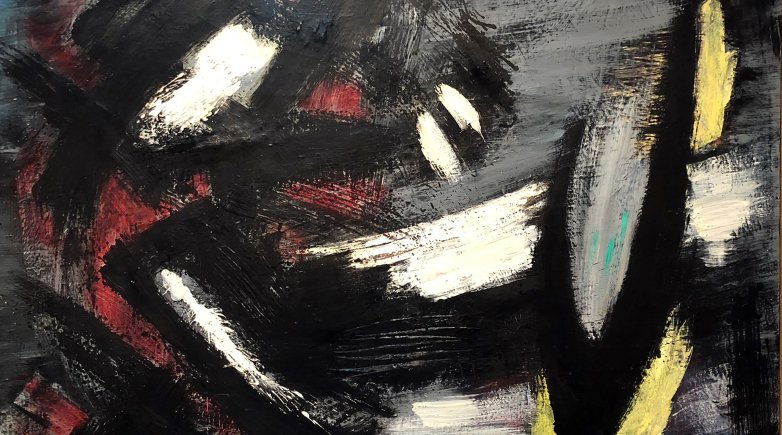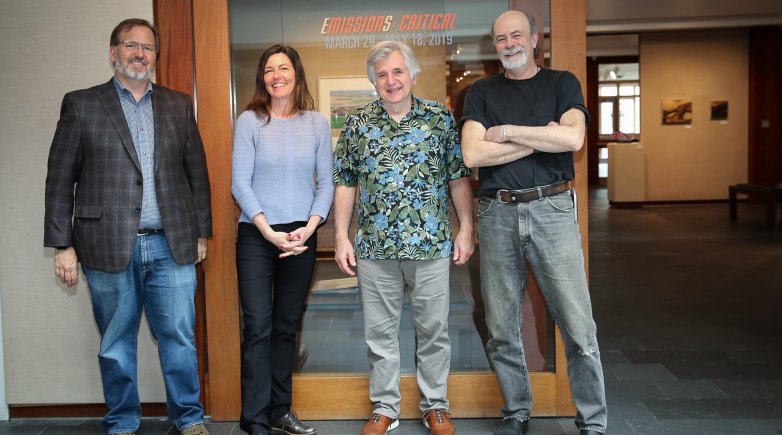Lamont Gallery takes stock of its own treasures
The current exhibition Managing Miscellanea offers mystery and excellence in equal parts.
A piece from Lamont Gallery storage just discovered to be an important gem in the collection.
The wonder of art is born, in large part, from the imagination of the observer. The artist renders the work, and the observer fills in details. Managing Miscellanea, the exhibition currently running until Sept. 24 at the Lamont Gallery, has been curated by Gallery Manager Stacey Durand and Exhibitions and Collections Manager Dustin Schuetz from the Lamont Gallery's art collection. While there are many impressive and evocative pieces on display, details of their provenance are scarce, and this is what makes the exhibit so intriguing. The gallery managers know for certain that the collection ranges from known works of importance by influential artists to work left behind by students. Wondering which is which is the fun of the exhibition and walking through it gives the undeniable feeling of having wandered into a treasure hunt.
Since its inception in 1952, developing a collection has never been part of the Lamont Gallery’s mission. Despite this, it has accumulated 700-800 prints, paintings, sculptures and artifacts, which comprise, inescapably, a collection. These works have arrived under a variety of circumstances: donations, bequests, student work and, in at least one instance, an unexpected truckload. What may not occur to a well-meaning donor is that stewardship of this art; keeping it well maintained, properly stored and documented over time are all part of the calculation in accepting an item. Because of this, the Gallery has ceased accepting new additions for the last seven years. In the meantime, Schuetz has been charged with uncovering as much possible about the collection and he has been making some impressive progress.

Two of the most important works in the Lamont Gallery's collection are paintings by Diego Rivera, the famous Mexican muralist and husband to Frida Kahlo. Both are currently on loan, one to the Museum of Fine Arts Boston and the other to the San Francisco Museum of Modern Art for its exhibition “Diego Rivera’s America.” A replica of this second piece, a portrait of Corliss Lamont, is displayed for the Managing Miscellanea exhibition.
Corliss Lamont graduated from Exeter in 1920. He was a humanist philosopher, author, poet and the director of the American Civil Liberties Union for 30 years. His family were all major donors to Phillips Exeter, with seven of them graduating from the Academy between 1888 and 1942. The Lamont Room in the Academy Library and The Lamont Poetry Fund which supports visiting poets, were both named after Corliss Lamont. The Lamont Gallery is named after Corliss’ nephew, Thomas Lamont II ’42, who died in World War II. Frida Kahlo died during the painting of this portrait and calla lilies, her favorite flower, figure meaningfully to the side of Lamont in the picture.

While the Rivera works are known to be important, another piece hangs across the gallery with a backstory only just discovered during the writing of this article. The large dark background pops with swaths of color, and the author’s signature is illegible but for the first three letters “Sch.” On the back, a label with cryptic markings provides clues: the word Kootz appears along with a series of numbers and letters “76 B” “6.55” and “VI.55.” They could be the title, the date or some other record of the work.
Kootz was a gallery which existed in New York during a short period from the 1940s to the 1960s and hosted works by famous abstract expressionists of the time including Picasso, Robert Motherwell, Jackson Pollock and Willem de Kooning. The idea that this piece was there, rubbing frames with the greats, sent Schuetz to search records of the Kootz Gallery housed at the Smithsonian and he was able to determine the work to be that of Gérard Ernest Schneider, a major pioneer of the style known as Lyrical Abstraction.
A casual Google search of the artist’s name, now that it is known, turns up images with striking similarity to the painting owned by the Lamont Gallery, but this answer is only obvious once the mystery has been solved. Certainly, experts might be brought in to speed the effort, but this work is but a single example among hundreds with literally no organizing principle guiding their presence in the Lamont Gallery collection.
Nevertheless, experts do visit the Academy periodically. Recently an alumni artist came to lecture and, during a display of her works, Schuetz noticed an item bearing strong resemblance to an unsigned piece in the collection. When shown the painting, the artist confirmed that its similarity, much like the Googled pictures of Schneider’s work, meant that it was undoubtedly hers. During our visit to the gallery, the piece was being packaged up for transport back to the collection of its creator.
Art from former students and faculty
Another abstract piece suspected to be the work of a former student dominates one of the first walls in the exhibit. This oversized triptych of irregular panels bursts with geometrically precise color. There is a small signature and the likely date “’73” at the bottom of the work. The only clues to proper assembly are the holes on the back of the frame. Though the frame is slightly damaged, it’s easy to understand Schuetz and Durand’s urge to assemble it once it was found in storage. Nothing more is known about the piece beyond its innate appeal, but the guess is that it was displayed for a few years and then moved to storage.

By contrast, an impressive and mature looking abstracted cityscape of the Italian city of Matera at the back of the gallery expertly blends color and suggests clear artistic mastery even to the untrained eye. This painting was done by a former head of the gallery, the late Glen Krause. An instructor emeritus, Krause served as an art instructor at Phillips Exeter from 1946-1966, chair of the Art Department from 1962-1966 and director of Lamont Gallery 1953-1966. His three sons attended Exeter. The artist had a stroke later in life, and there is a clear demarcation in his style from before and after. This piece is meaningful as a representative of the artist’s work before the impact of the stroke.

A low-lit side room is devoted to World War I and II posters, with wartime slogans in French and English. Their vividness is even more surprising given that they are printed on fragile newspaper. The colors have been preserved by decades spent safely, but unfortunately folded, in dark storage drawers. It is suspected that they may have been left to the Gallery by a history teacher but why or what their significance may be is currently unknown. Nevertheless, they are impressive examples of their type.



Indeed, the entire exhibition, with its air of mystery and undeniable excellence provides impressive examples of technical mastery, specific styles and certainly any number of notable tales of provenance just waiting to be discovered by the gallery managers, students of the Academy or perhaps even by you should you find time to visit before it closes. The Lamont Gallery is open to public visitors by appointment. Please go to the “Visit the Lamont Gallery” page of the Lamont Gallery website to make an online reservation.


